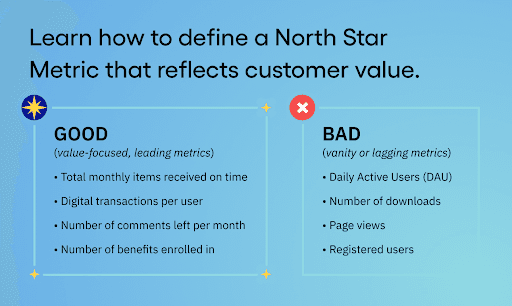What Makes a Good vs Bad North Star Metric
Discover what makes a good North Star Metric, how to avoid using bad ones, and examples of each.
There’s no one-size-fits-all approach to the North Star Metric. It's different for every business, and to make things more complex, it also changes over time. Heck, at Amplitude, we’ve changed our North Star Metric at least three times as we’ve evolved and tweaked our strategy.
But just because your North Star Metric will be unique to your company doesn’t mean you're lost in the woods or need to reinvent the wheel. We’ve facilitated dozens of North Star workshops and helped hundreds of companies define the right North Star Metric for their organization. In this blog, we’ll explore the characteristics of a good and bad North Star, best practices to define yours, and traps to avoid.
What is a North Star Metric?
A North Star Metric is a single metric that best captures the value customers derive from your product. It’s defined by three core qualities:
- It represents the value users get from your product.
- It’s within product and marketing’s sphere of influence.
- It’s a leading indicator of revenue.
For example, a SaaS company with a self-serve business model like that of Dropbox or Hubspot might use something like “trial accounts with >3 users active in week 1 ” as their North Star Metric. Why that and not something broader like total free trial accounts?
This more precise metric—"trial accounts with >3 users active in week 1”—provides more insight into the value the account is getting and provides a signal of future trial conversion and subscription revenue that the product team can predict and drive.
Below are additional examples of Amplitude customers’ North Star Metrics by industry.
| Industry | North Star Metric Examples |
| Finserv | Gross Processing Value (captures value delivered to sellers) |
| Monthly transacting users | |
| Bank linked accounts | |
| Total net users funded | |
| Retail | # of purchases per premium subscriber |
| Total month items received on time | |
| B2B | Average records created per account |
| # of organizations that send > 2000 messages monthly | |
| Media |
Time spent listening to music |
| % of premium users | |
| Total time users spend reading content | |
| Median view hours per month | |
|
Hospitality/Travel |
# of nights booked |
| # of seats purchased |
North Star inputs
Your North Star Metric doesn’t stand alone—it’s part of the North Star Framework. The North Star Framework is a strategic product management approach for discovering and implementing your North Star Metric. It includes the North Star Metric and a set of equally important key inputs.
Inputs are typically a set of three to five influential, complementary factors that you believe most directly affect your North Star Metric and that your teams can directly influence with their day-to-day work through your product offering.
Your North Star Metric is an outcome or output, meaning its value depends on changes in your inputs. As such, you shouldn’t be able to influence the North Star directly.
“If you can move your North Star directly, it’s probably not a good North Star,” explains John Cutler, former Amplitude Product Evangelist and co-author of The North Star Playbook. The goal of the North Star is to be one level out of reach. It’s to get people thinking about why that's going up or why that's going down. It’s meant to be a composite of the parts of the company working in tandem.”
Put together, the metrics and inputs look like this:

Inputs vary greatly by industry, business model, and a product’s unique characteristics. The trick is to identify the key factors that contribute to your business’s North Star Metric. We view the North Star Metric as a function of key inputs that are both descriptive and actionable.
Let’s say your product is a grocery delivery service, and your North Star Metric is the total monthly items received on time. Your team selected this metric over something like “total number of items delivered monthly” or “total order value” because your data shows that customers value on-time deliveries, and they’re a strong predictor of future purchases.
Four key inputs to drive that metric could include:
- Driving customers to place lots of orders
- Encouraging orders with lots of items
- Fulfilling lots of orders
- Delivering orders on time
What makes a bad North Star Metric?
Though no metric is inherently bad—they all tell you something about your business—there are definitely good and bad ones when it comes to your North Star. Like the early-2000s show “What Not to Wear,” it’s often easier to start with what not to do—or in this case, what makes a bad North Star.
The following are characteristics of bad North Star Metrics.
Vanity metrics
Though some metrics might make you feel good about your performance in the short term, they don’t always actually tell you about your product’s long-term success. These are vanity metrics.
Be wary of choosing vanity metrics for your North Star Metric. They look great on the surface but don't translate to meaningful business outcomes or tell you about your product’s long-term success.
Consider, “How helpful is this metric really?” If you can’t confidently answer, then it’s not a good North Star Metric candidate.
Lagging indicators
Some metrics tell you what has already happened to your business; these are lagging indicators. Lagging metrics like “Monthly Recurring Revenue” or “Average Revenue per User (ARPU)” aren’t optimal North Star Metrics because they tell you what happened in the past rather than predicting future results. Leave the past in the past, and focus on leading indicators.
Over focus on revenue
While North Stars should be a leading indicator of revenue, they shouldn’t over focus on revenue. Why? Revenue is a lagging indicator. With revenue, what’s done is done—meaning, you can no longer impact the outcome. So “don’t” make revenue your North Star Metric, but “do” relate your North Star Metric to revenue.
“If your North Star is flat, then expect your revenue to be flat,” explains Ted Clark, Senior Customer Success Architect at Amplitude. “But if at any point your North Star isn’t directionally indicating where your revenue is going, then it’s time to revise it.”
Examples of Bad North Star Metrics
Though each of these metrics is useful to track, they do not make good North Star Metrics. They are good reference points in the context of the bigger picture, but making them your beacon for success will lead you astray.
- Annual recurring revenue (ARR) and monthly recurring revenue (MRR)
- Daily Active Users (DAU)
- Ad impressions
- Number of downloads
- Page views
- Registered users
- Story points delivered
- Time on page

What makes a good North Star Metric?
Now that we’ve dealt with the bad, let’s focus on the good. The following are characteristics of good North Star Metrics.
Focuses on customer value
A good North Star Metric represents what customers value about your product. When teams fail to connect their North Star Metric to customer value, they risk leading their business down the wrong path and ending up with one of the “bad” metrics above.
For example, knowing how many registered users you have is nice, but the number tells you nothing about what those users are doing and what value they're getting. If your North Star doesn’t reflect customer value, you’ll struggle to understand how to improve business outcomes.
Reflects your company vision
If you’ve built a strong North Star, someone should be able to read it and understand your company’s product strategy and vision—at least at a high level. We generally recommend that your North Star be unique to your business and express your company’s and your product’s strategy and mission. That way, when teams align their activities to your North Star, they deliver work that furthers your strategy.
Actionable and measurable
Your North Star should be something you can influence or change. This means it shouldn’t measure a broader market trend or reflect real-world realities that would be true whether or not your product existed.
Additionally, you need to be able to collect the appropriate data to track and communicate your North Star Metric. However, avoid the trap of thinking that your North Star must be something you can measure with your current data and tools. In many cases, you'll be able to measure what you want with just some light instrumentation and investment in new tools, or even just improvements in communication and relationships.
North Star checklist
We developed the North Star checklist as an actionable cheat sheet through which teams can evaluate current or prospective North Star Metrics. It’s helpful to review the checklist as a group to elicit differing perspectives, foster healthy debate, and ultimately agree on what would make a good North Star for your company.
Mirroring this blog’s format, spend a few minutes brainstorming what a terrible North Star would be for your company. These anti-examples free people’s thinking and can set helpful guardrails when defining your metric and inputs later.
Define and track the best North Star Metric with Amplitude
There are no silver bullets to success, but defining and uniting your teams behind a good North Star Metric can be the key to unlocking improved outcomes. And while recognizing the difference between a good and bad North Star is great, it’s only the first step in your North Star journey.
You can use our North Star Playbook to learn:
- The purpose and value of the North Star Framework.
- Understand the elements of the North Star Framework.
- How to define and name a North Star Metric (and related inputs) for your company.
- When to change your North Star Metric.
- How to integrate the North Star Framework with your development process.
- Prepare you to facilitate an internal North Star workshop.
Want to learn more about the North Star? Get your copy of The North Star Playbook, and check out our North Star videos, blogs, and resources.

Julia Sholtz
Former Group Product Marketing Manager, Amplitude
Julia is a former product marketer at Amplitude. She focuses on go-to-market solutions for enterprise customers.
More from Julia




